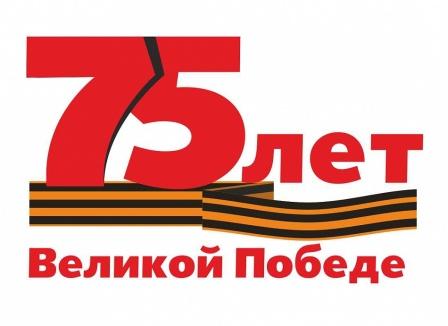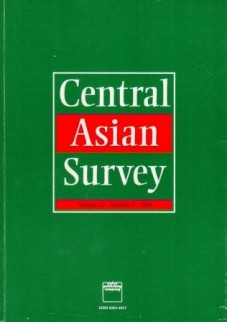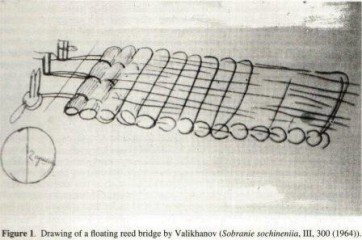The history of Euroasiatic peoples abounds with evidence of mass migrations and campaigns from Central Asia westwards to the Dnieper,
the Danube and the Adriatic Sea. Scythians, Huns, Avars, Pechenegs, Polovtsians, Mongols, and Tamerlane travelled thousands of kilometers, crossed hundreds of small and medium-sized rivers and dozens of large ones. Yet ancient and medieval authors do not often divulge just how great masses of people overcame river obstacles. It is obvious that crossing a large river could be accomplished in winter only on ice and in summer by fording or swimming. For such rivers as the Irtysh, the Volga and the Dnieper, swimming was impossible especially during the cold transitional seasons, and they could not be forded in their lower courses.
What we nowadays understand as bridges appeared over these rivers only in the nineteenth century. Crossings were accomplished by means of ferries and traditional craft. But ferries and boats are properties of a settled population, not a nomadic. Military units of nomadic peoples undoubtedly used ferries and boats for their purposes, but only episodically where woodlands existed. They did not refrain from using such elements of the culture of civilized sedentary peoples as bridges constructed of stone, brick or timber. It is known that over the Ural river near the former Golden Horde town of Saraichik there existed in the fourteenth century a floating bridge described by Ibn-Batuta as ‘similar to the one at Baghdad’.
In the thirteenth century the Ili river was crossed by boat, the Chu by a plank bridge, and the Talas by an arched stone bridge. These modes of crossing already existed during the first years of Mongol occupation of the territory of Kazakhstan and Central Asia. They were undoubtedly created not by the nomadic Mongols but by peoples settled on the Silk Road long before the Mongol invasions.
In the tenth century when Ibn-Fadlan led an embassy from Baghdad to Bulgar, he was advised in Urgench to acquire ‘travel sacks made of camel hide for use in crossing rivers ... in the land of the Turks’. (1) These camel sacks were used as floating capsules, in which were stored food, clothing, weapons, and the ambassador’s gifts, but they were also employed as boats on which people, small livestock and camels could cross a river. Horses always crossed by swimming. En route to the country of the Volga Bulgars one had to overcome rather large rivers such as the Sagiz, the Emba, and the Ural, as well as dozens of lesser streams, which in spring produced floods and swift currents. Ibn-Fadlan set out at the end of winter. aiming to complete his journey by fall. His ambassadorial caravan consisted of three thousand horses and five thousand people.
The caravan used sacks for the first time to cross the small currentless Shagan river at the northwest shore of the Aral Sea. Ibn-Fadlan has given a description of this crossing. ‘Men got out their travel sacks, which were made of camel hide. After spreading them on the ground they packed them with clothing and household things, and when they were filled and floated people sat down on each travel sack in groups of four, five, or six, more or less. Using poplar branches as oars, they steadily rowed, and the water bore their rotating travel sacks until they reached the other bank’. (2)
It is well known that even in Mesopotamia and ancient Greece goatskins filled with air were used by individuals for crossing rivers. In the Assyrian Hall of the Pushkin Fine Arts Museum in Moscow there is a copy of a has-relief of ‘warriors crossing a river on wineskins‘. Such ‘fioats’ are still being used by the mountain peoples of western China. Ibn-Fadlan’s information about group crossings on camel hides appears to be unique in medieval sources.
In their everyday life the nomads of the Kazakh steppes regularly changed pastures, and in moving from place to place had to travel tens and hundreds of kilometers and overcome several water barriers. They had no flotation means and did not know how to make them. Trees were a great rarity in the expanses of steppe and semi-desert. So, how did they overcome water barriers? Livestock and male adults swam across. For women, children, sick persons and household belongings, rafts were constructed from reeds and rushes. Fortunately reeds grew almost everywhere along riverbanks. Readily obtainable, they were bound into thick bundles, and rafts were made of these bundles. The width of the raft was limited by the length of the cut reeds, while the length of the raft could be any size, depending on agreement of the customer and the maker. The preparation of a reed raft required no special knowledge, skills or experience.
In notes left by the mining engineers Pospelov and Burnashov, who in 1800 travelled from the Kolyvansky factories to Tashkent to help local authorities in their search for useful ores, the following information about the Chu river is given: ‘The river is very deep, without fords anywhere, and therefore caravans cross it on rafts made of reeds, which grow so strong and high that axes are needed to cut them down. There are no forests along the river’.(3) In 1811 Mamediiarov noted that his caravan crossed the Chu at Kok-Murun ‘on reed rafts made by the Kazakhs’, and the Arys river ‘on willow rafts’.(4) In his diary Lieutenant Teliatnikov noted on June 17, 1797: ‘I arrived at the Chu river, where the whole caravan crossed on volozha made of reeds and stayed overnight on the far bank’.(5) The meaning of the word ‘volozha‘ in Teliatnikov’s old notes is not quite clear. This strange word probably stands for ‘raft’. The crossing took place on the lower Chu. Nikolai Il’ich Potanin, who in 1829 made an official trip from Omsk to Kokand, gave the following information: ‘For river crossings bundles of reeds are tied together with lassoes and used as a kind of bridge, and a large caravan can go across without danger’.(6)
This information is unusual and novel, and not quite understandable in detail. A bridge of reeds? Did Cornet Potanin make a slip of the pen? No, not so, since a few lines later he writes that, at another branch of the Chu river, ‘They crossed on a reed bridge constructed by a Tashkent caravan’.(7) He really did mean a reed bridge. This bridge was thrown up by caravan people. It worked! They were used to engineering activity, and fortunately the lower Chu was rich in reeds and rushes. Information about the ability of nomads in the Kazakh and Central Asian steppes to fashion reed rafts and use them for crossing rivers says nothing at all unusual, but information about reed bridges in light of the bridge-building technology of that time is truly unusual. And unexpected. Neither technical nor historical literature contains anything similar to it. Historians and ethnographers of nomadic peoples pass over in complete silence the question of ways of overcoming water obstacles. Yet one would think that they would have to pay attention to the information frequently given by members of ambassadorial and commercial caravans on the use of reeds for crossing rivers. In Potanin’s report there is an unclear but intriguing phrase: ‘On October 30-31 a detachment crossed on a raft made of wagons’. Surely in this phrase Cornet Potanin errs owing to incompetence in technical matters, for he does not feel or sense the actual distinction between a ‘raft’ and a ‘bridge’. Not rafts but bridges were made of wagons.
The site for a temporary bridge to be made of wagons was selected where the water was not deep, the current was slow, the bottom firm and uneroded, and the banks gently sloping. The technology for constructing wagon bridges is described in rare publications.(8) On the riverbank the wagons were lined up close to each other so that the shafts of one wagon overlapped the frame of another. The wagons were then fastened together with ropes or the rawhide straps widely used at all times in cartage. This joining secured a semi-rigid linkage for a line of wagons. Then a group of horsemen forded the river to the opposite bank, dragging along a rope attached to the front wagon. With this rope the line of wagons was drawn into the water and pulled across to the far side. To keep the wagons from being swept away by the current, they were loaded with stones.
Not only in the nineteenth century but also during the Middle Ages in Eastern Europe recourse to constructing wagon bridges across shallow rivers was taken in extreme necessity, i.e. during military campaigns when fords or permanent bridges were absent. In Central Asia instead of wagons [telega; pl. telegy] the two-wheeled cart [arba; pl. arby] was used. Among the Uzbeks the wheels of the arba were huge, up to two meters in diameter. In the words of a nineteenth-century writer, they offered ‘exceedingly slight resistance to the water and therefore were a favorite means of transport in crossing mountain streams’. This author testified that, during strife between the Bukhara and Khiva Uzbeks, ‘the armies of the former were brought across the Amu-Darya at Chardzhou on carts where the water was so deep and rapid that it swept horsemen off their mounts’. (9) Cart bridges on such a river as the Chu in its upper course could be constructed and disassembled within a few minutes. It must be supposed that cart bridges were invented by inhabitants of Asia a long time ago.
But now to return to the reed bridges. Here we are less fortunate, for compared to our information about wagon bridges die evidence about reed bridges is more scant and comes from persons unburdened by knowledge of engineering.
When preparing for his journey to Kashgar, Chokan Valikhanov in 1856 and 1857 assiduously collected information about routes to Kul’dzha, Kashgar, and Tashkent. Working in the archives at Omsk and Semipalatinsk, he recorded accounts left by predecessors about the trade routes taken by them. Making a copy of Mamediiarov’s notes mentioned above (that the Chu river was crossed ‘on reed rafts made by the Kazakhs’), Chokan Valikhanov with a few strokes made a drawing bearing the inscription, ‘a reed raft on the Chu’. But this was not a raft but a floating reed bridge. The drawing must have been momentarily associated with a bridge seen by Chokan sometime earlier. An excellent graphic artist, Valikhanov depicted very exactly the structural solution of fastening to the far bank the cables of the bridge. In his drawing can be seen three sets of stretched cables. Two sets are marked by two pen strokes each, and the third (middle) set by three. Evidently each pen stroke indicates a strand of the cable, which was made of rope or rawhide. Their ends were first wound around wooden stakes driven into the earth and then knotted. On top of the cables was arranged a fascine flooring of bundles of reeds. The bundles are tied in three places and rest upon the three cables. The fascine flooring provided a rapid and safe crossing, and served as a protective layer securing the stretched cables from damage by wheels and the hooves of horses, bulls, sheep and camels. The pressure of wheels and animal legs is relatively evenly distributed over all three cables by the flooring of reed bundles. Except for this unassuming and sketchy ink drawing no other depictions are known to us of a floating bridge made of reeds. an unusual material for making bridges. For this reason the drawing is valuable as a unique representation.
Fortunately we possess two relatively detailed and exact written descriptions of reed bridges. A young officer named Egor Kazimirovich Meyendorf, a Baltic baron, made a journey from Orenburg to Bukhara as a member of a mission headed by A. F. Negri. Subsequently he wrote about his trip and gave a description of a reed bridge seen by him in 1821. ‘On returning from Bukhara we found ourselves at a place on the banks of the Kuvan-Darya where remains of a reed bridge existed. To restore it, large bundles of reeds were tied together and laid on two cables, also interlaced with reeds and attached to stakes on either bank. Thick ropes were added and the number of fascines were increased, and the result was a bridge on which camels could easily cross. We had to make haste, lest the swift current sweep away this floating bridge‘.(10)
The other description is in the article, ‘Improvised bridges over the Syr-Darya’. signed A. Ch., in the newspaper Ural’skie voiskovye vedomosti.(11) Accidentally coming across the title of this article in a book of pre-Soviet vintage, my attention was aroused. A photocopy was ordered from the Saltykov-Shchedrin Library in Leningrad. The article contains unusual information overall, and in particular about the construction of reed bridges. It is unique. Published in such a rare journal, it has remained completely unknown to ethnographers and historians of technology. This circumstance as well as the detailed information about the way the construction was organized impel one to present its contents with only insignificant omissions, while preserving the flavour and distinctive quality of the author’s story:
During my service at Fort Perovskii in 1853-1854, I often heard of bridges built by the Kirghiz [Kazakhs] over the Syr-Darya... Knowing well the engineering capabilities of the Kirghiz and taking into consideration the width (100 to 300 sazhens) (12) and swift current of the Syr-Darya, I was dubious, as for a long time I had sought an opportunity to satisfy myself as to the actual existence of these ‘improvised bridges‘. I did finally have a chance to witness the building of one of these bridges. On December 4, 1854, I was dispatched with a detachment of Cossacks to supervise a river crossing by Kirghiz [Kazakhs] of the Siberian Horde, who were moving to winter quarters in Khivan territory, on a bridge to be built over the Syr about eight versts downstream from our fort. Arriving at the place, I found about three hundred Kirghiz preparing the reeds and kuga [popular name for one type of reed]. On the next day the construction of the bridge began. A hole about two sazhens square was dug on the bank, While some were digging, others were twisting reeds with kuga, making cables as thick as a man's arm, and with these cables formed four larger cables about six vershoks (13) in diameter and thirty sazhens in length. At the ends of these larger cables great knots were made and put into the hole, two at the sides and the other two in the middle, all equidistant from each other. The hole was then filled with earth and firmly pounded. Afterwards on this embankment a slope leading to the bridge was formed. The free ends of the cables were then laid out along the riverbank in a direction opposite to the current, and sufficient additions were made to result in cables long enough to extend across the river when eventually put into place. While all this was going on, the roadbed of the bridge was being prepared. The Kirghiz would take two small bundles of reeds, lay them so that they overlapped each other about one quarter of their length, and repeat this process until larger bundles were created that were about two sazhens in girth and somewhat wider than the total width formed by the four cables and the spaces between them. They took these bundles by the ends and middle and placed them across the cables, and then tied them tightly to the cables and to each other. In ten days the roadbed of a bridge long enough to span the river was completed. After this most of the Kirghiz swam over to the opposite shore and began there to prepare another hole just like the first one. Of the remaining men about twenty set out in small boats, having tied their lassos to the free end of the bridge, and the rest carefully shifted the bridge into the water. The swiftness of the current did not break the resilient bridge but instead began slowly to turn its free end to the opposite shore, and this movement was reinforced by those in the boats pulling on their lassos. When the free end reached the opposite bank, all the Kirghiz tied their lassos to stakes driven into the ground, quickly inserted the ends of the cables into the prepared hole, and firmly packed the hole with earth. To prevent livestock from destroying with their hooves the knots holding the bridge together, an especially thick layer of reeds was added the whole length of the bridge. Now the bridge was ready. The next day an endless line of fully-loaded camels and thousands of other livestock moved across this improvised bridge. The bridge seemed not to feel all that weight, and the following incident proved its strength once again. On December 18, after cold weather had set in, ice floes appeared on the Syr, getting thicker and thicker during the next five days. It seemed unavoidable that this mass of ice would destroy the bridge, but this ‘living’ bridge held together without damage and the crossing ended successfully within a few days. Yet everything under the moon is mortal! On December 26 at about 2 a.m. the bridge finally broke apart with a loud rumble and was carried away by the mass of ice it had long contained. Having watched the construction of such a bridge, one can’t but admire the skill and boldness with which the Kirghiz mastered this problem and the patience and tirelessness shown while doing this difficult work. Doubtless the invention of these primitive bridges belongs to a more powerful people than the Kirghiz and was provoked by more compelling reasons than a crossing by a Bukhara caravan or the simple migrations of nomads. By using such bridges rapid movement from Asia to Europe and back must have been accomplished in ancient and medieval times by hundreds of thousands of warring hordes.
It is impossible not to share the author’s admiration of the coordinated effort made by this large group of people in creating a reed bridge as well as their ability to use in their favour the special features of the river. The bridge-builders were directed undoubtedly by experienced and knowledgeable supervisors. It took them only fourteen working days to construct the bridge! Both the simplicity of the construction and the modest array of building materials and instruments (reeds, kuga, ropes, knives) deepens even more the admiration felt by the reader of A. Ch.’s article from Ural‘skie voiskovye vedomosti. Few have become cognizant of this article, for it was virtually unobtainable outside the territory of the Ural Cossack Army, and so for more than a hundred years its contents have remained unknown to the engineering profession. An even more unexpected discovery was the pen-and-ink sketch of a floating reed bridge drawn by Chokan Valikhanov. The drawing was published in 1964, and yet for almost twenty-seven years its real content has remained unidentified, unrevealed and misunderstood. The single main reason for this accident was the misleading and mistaken inscription under the drawing.
The information we have about reed rafts and bridges and the use of carts and wagons as temporary bridges in the nineteenth century can be transferred back into the Middle Ages, and we can thus get an idea of the methods and technical means used by peoples of the Asian continent in overcoming steppe and mountain rivers, both in times of large-scale military activity and also during the movement of commercial caravans and of nomadic villages in their customary seasonal migrations. Confirmation of this retrospective prognosis is given in the book, Istoriia gosudarstva Kidanei, written by a Chinese official in 1180. The state of the Khitans, who were of Mongol stock, lay to the northwest of China. At the close of the first millenium AD and the beginning of the second the Khitans were using floating bridges to cross rivers. (14) At large rivers ‘they bound together brushwood for crossing, and sometimes made boats of skins ... and when they had to move wagons across, they used square boats or three boats joined together’.(15)
Thus, a thousand years ago in the Far East, they were able to make rafts from brushwood and tree branches, boats from the hides of large animals and ferries from boats.
All these means of overcoming water obstacles were used by nomads on the territory of Kazakhstan even in the twentieth century. For example, an archival source (16) contains the following information for 1902: ‘During migration periods the dzhataki [the poorer, sedentary Kazakhs] set up floating bridges on the Turgai river in two places’, at Dzhangel’dy and Bestiube. Such bridges were costly for the Kazakh builders (‘up to 2000 roubles each’). Moreover, these primitive floating bridges had no railings and much livestock was lost in crossing. Unfortunately the source does not indicate the material used, reeds or wood? The district authorities, to satisfy a petition from the nomads and wishing to prevent livestock losses, ordered the engineer N. Naronovich to draw up a technical design for a wooden bridge and an estimate of the cost of construction. A design was prepared for a bridge thirteen sazhens (27.7 metres) in length and 6.5 arshins (4.6 metres) in width. The whole structure was to rest on twenty-four piles. The cost was set at four thousand roubles. Materials were supplied from Kustanai, and the bridge was built in 1904.
Interesting information about the ways of constructing bridges is contained in other archival material for the years 1913-1915. (17) The Nura river in its lower course flows between high banks and is rather deep. Hence it offers no place for fording. During summer migrations the nomads were compelled to employ the costly services of ferrymen to move their livestock, household belongings and families. The ferrymen operated with boats and wooden rafts. In 1906 a not very well-to-do Kazakh from Dzhaksykonskaia volost, Baimagambet Ainabekov, ‘prompted by religious conviction, decided that rather than making the pilgrimage to Mecca he would benefit his people by constructing a wooden bridge at a place called Kutemaldy’. Ainabekov paid 3500 roubles to have the bridge built by his compatriots. Ten sazhens in length, the bridge had three spans, and was protected by dams totalling thirty sazhens in length. But each year ice drifts necessitated repairs to the bridge, which were paid for by Ainabekov. Having spent 1500 roubles for repairs during the first six years, Ainabekov in the end brought himself to ruin. In 1913 the local authorities wrote that ‘at present the repairs have exhausted the means of the builder, and the Kirghiz [Kazakhs], anxious to keep the bridge, request state funds for construction of a permanent bridge over the Nura. Thereafter they themselves will assume the annual expenses for maintenance and repair. Ainabekov’s bridge is not reliable and can at any time be swept away by the water’. And, in fact, at the beginning of the following year it was destroyed, the wooden material born away by the current. Restoration of the bridge was necessary, as the district chief and the regional manager of resettlement affairs informed the governor of Akmolinsk, for in their opinion ‘its location was on a main road and the only place where one could get across the Nura river’.
Construction of the bridge was put off until 1916 owing to lack of funds and the need to carry out technical research and draw up a design. But by 1916 the economic situation in Russia had deteriorated. And at the front there were military setbacks, causing the call-up of a significant part of young Slavic males in Akmolinsk region and thus reducing the labor force. Among the Kazakh population in the neighbourhood hostile attitudes had developed in protest against the drafting of its youth into military labour units and into construction and factory work. It is doubtful that the bridge was built in 1916 or during the next decade.
Notes
1. Materialy po istorii Turkmenii i lurkmen, Moscow, 1939, p 158.
2. Ibid., pp 163-164.
3. Vestnik IRGO, Part 1 (1851).
4. Ch. Ch.Valikhanov, Sobranie sochinenii, Vol III, Alma-Ata, 1964, p 300.
5. Ibid., p 292.
6. Ibid., pp 223-224.
7. G. N. Potanin, Puteshestwiia po Mongolii, Moscow, 1948, p 242.
8. Turkestanskie sapery 1866-1891, Tashkent, 1983, p 328, Inzhenernyi zhurnal, No 8, 1873.
9. P. Kol’devin, ‘Razrabotka kolesnogo puti v Tian'-Shane’, Voennyi sbornik, No 7, 1873, p 183.
10. E. K. Meyendorf, Puteshestvie iz Orenburga r Bukharu, Moscow, 1975, p 44.
11. No 23, 1867.
12. One sazhen equals 7 feet or 2.13 metres.
13. One vershok equals 1.75 inches or 4.44 centimetres.
14. E. Lun-li, Istoriia gosudarstva Kidanei, Moscow, 1979. pp 129, 319-320 and 442.
15. Ibid., pp 332, 342 and 537.
16. TsGA respubliki Kazakhstan, f. 25, op. 1, d. 1693, l. 21.
17. Ibid., f. 369, op. 1, d. 8412, l. 6, 20, 23, 26, 28.
Translated from Russian by M. M. Ginatulin with assistance from K. E. McKenzie.
Central Asian Survey (1994), 13(3)
От редакции сайта:
Статья Н.П. Ивлева и М.Н. Ивлева ‘River crossings and bridges of nomads’ («Переправы и мосты кочевников») из журнала ‘Central Asian Survey’ (“Центрально-Азиатское обозрение»), Vol. 13, Numb. 3, 1994, Лондон, Великобритания.










